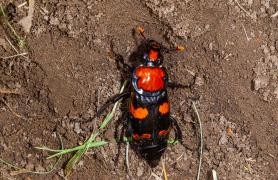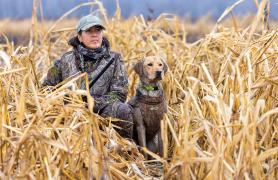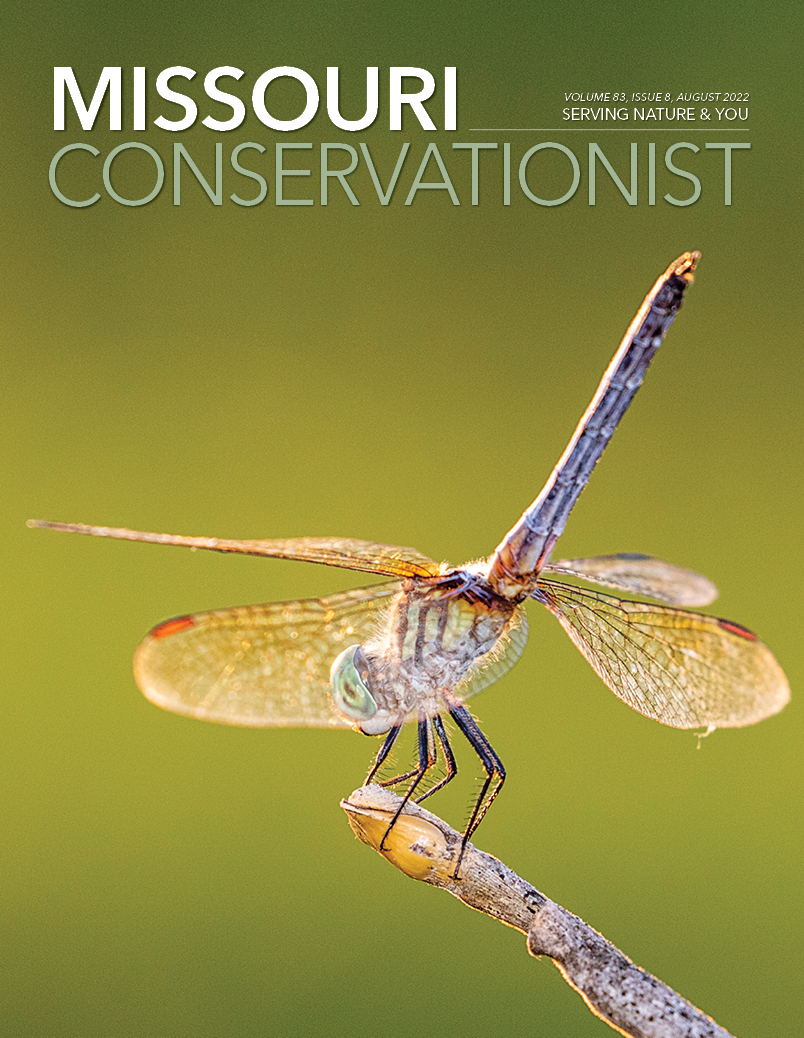
One of the great things that many Missouri residents enjoy is the changing seasons. While we often joke about the weather — it’s too hot or too cold or too wet or too dry — we are truly blessed with a climate that allows us to witness seasonal changes and nature’s response to those changes. For many Missourians, fall and winter are the most anticipated time of the year. After several months of hot, muggy summer days, the arrival of fall heralds the promise of cool mornings, fewer bugs, and the opportunity to head afield in pursuit of game. Squirrels are actively cutting nuts and storing food, ducks begin arriving from their summer breeding grounds, whitetail bucks shed their velvet and begin making scrapes, and family groups of wild turkeys roam the woods and fields in search of the extra calories that will see them through the winter.
For most hunters, it’s hard to beat the fall. No matter what game species you’re passionate about pursuing, fall is a fun time. In September, habitat managers still have time to get in the field and plant food plots, run a chainsaw, and fine-tune water levels in their duck marshes. As October rolls around, days are getting noticeably shorter, and nights are getting cooler. Bucks become more solitary and start taking an interest in does and the impending breeding season. Bobwhites experience the “fall shuffle” as broods disperse and intermix to form coveys. Most fawns have lost their spots and deer fur changes from its summertime red to the thicker, more muted gray coat. The shorter days and cool nights foster a decline in chlorophyll in many plants’ leaves, allowing other pigments to be expressed and offer a kaleidoscopic rainbow of colors that provide a brief but spectacular natural display that makes us want to be outside every possible moment, knowing that all too soon it will be gone.
And then comes November. Perhaps no other month is as eagerly anticipated by hunters as November. Even many non-hunters know this is the month of the whitetail rut, when does and bucks alike are liable to be seen at any time of the day. November cold fronts cause us to look to the closet for a warm coat, and to the skies for flocks of mallards setting wings over a pool and skeins of geese flying in their V formation. Bird dogs pace anxiously in their kennels, eager to crisscross the fields and fencerows in search of quail and pheasants, and stepping outside in the evening, we’re likely to hear the mournful baying of a hound following the fresh track of a coon down by the creek.
Whether you’re brand new at hunting or you’ve been enjoying it for decades, the following are some of the activities you can look forward to as summer gives way to fall:
September:
- Scout soybean fields to locate late summer/fall food sources used by whitetails.
- Dust off your shotgun, grab a shooting stool, and head out with some buddies for a dove hunt. Many MDC conservation areas offer great dove hunting. Visit mdc.mo.gov/discover-nature/places to find an area near you.
- Cool September mornings are a good time to practice shooting your bow. Aim small, miss small.
- Take some time to tune your bow to optimize your shooting. Visit a pro shop if you’re not sure how.
- Scout for new hunting areas. Start with mapping apps such as OnX to locate likely spots, then head to the field to ground-truth those places.
- Mid-September sees the arrival of teal from their northern breeding grounds. Grab your decoys, small game permit, and Federal Duck Stamp and head out for a fun fall hunt on a local marsh or pond. Visit short.mdc.mo.gov/4SZ to see the Migratory Bird and Waterfowl Hunting Digest 2022–2023 for relevant information.
- Sept. 15 — archery deer season begins.
- Site prep food plots to be ready for planting small grains.
- Get in the woods and scout for good acorn production, especially looking for white oaks with heavy production.
- Chiggers are still out — spray your socks and pant cuffs.
October:
- Oct. 1 — fall turkey season begins. Get out in the woods. Practice your kee-kee calls, bag a turkey, and do some scouting for deer and squirrels.
- Finish hanging tree stands. Be sure to check stands for worn or broken hardware, replace frayed straps, and put lifelines and tree straps in trees.
- Plant cold hardy small grains for green browse: wheat, cereal rye, triticale, barley.
- Head to the local range and sight in your rifle or check its zero. Try several different loads to find the combination your rifle likes best.
- Hickory nuts, acorns, and walnuts are maturing — head to the woods and follow some squirrels, listening for them cutting nuts. You often hear them before you see them.
- Buy your firearms deer permits.
- Oct. 15 — rabbit season opens. Bag some rabbits and cook them up using your favorite recipe or try a new one.
- Deer movement can be very good around the first significant cold front in October —be ready to capitalize on the opportunity. Grab your bow and get in the stand.
- Scout field edges and ridgelines for deer scrapes. Hang a trail camera over a new scrape to see what’s using it. Cameras mounted above line of sight may be less likely to spook a wary mature buck.
- Make a mock scrape near a tree stand. Be sure to consider wind direction in choosing a location.
- Spend a Saturday afternoon shooting some clays to hone your wingshooting skills.
- Can’t find ammo? Buy the components and reload your own. Talk to an MDC range instructor to learn how.
- Got a new hunter? Get them enrolled in a hunter safety course.
November:
- First two weeks of November can be magical for deer activity — get in the stand with your bow as often as you can. Or simply sit and scout.
- Continue to practice with your bow. Make any necessary last-minute adjustments with your deer rifle and ammunition.
- Quail and pheasant season opens statewide. Call a buddy and walk some fields behind the dogs.
- Want to try something different? Head afield after woodcock. These plump migratory game birds frequent damp areas such as brushy creek bottoms.
- Want to find a buck? Find the does. As does come into estrus, bucks will start cruising the timber and scent checking feeding areas.
- Do your part to prevent the spread of CWD. Don’t move whole carcasses or brain/spinal tissue from counties with known CWD cases.
- Put out some trail cameras to get MRI — most recent information — on deer movement and activity. Compare to weather conditions such as wind direction, temperature, and barometric pressure. As you pattern the deer based on these factors, you’ll become a better hunter
- Whitetail deer breeding peaks around mid-November. Chasing activity — and hunting — can be very good.
Sometime between Thanksgiving and Christmas, outdoors people notice a change. The days are now very short, allowing less time for diurnal activities. For many wildlife species, this will be the most trying time of the year. Many bird species will migrate to warmer climates with more abundant food resources. Some mammal species, like the black bear, skunk, and groundhog, go into periods of extended inactivity or true hibernation, tucked away in dens underground. But for many other Missouri fauna, life must go on even when it’s hard. Animals’ coats by this time are dense, often with a thick underfur to insulate against the chill. Many species take advantage of sunny days resting in an out-of-the-wind patch of sunshine to absorb some solar radiation and reduce their energy expenditures. Survival becomes a delicate balance in which caloric intake must be managed against output.
But for the serious hunter, winter still offers plenty to do. Seasons are still open for a variety of game species, affording continued opportunity to get outside and engage with nature. Clear winter nights promise cold stiff fingers the following morning, but is there another time in which coffee tastes better or the sky seems bluer? Skim ice on the marsh plays a magical tune to the duck hunter breaking it as she sets out her decoys in anticipation of the morning flight. The sinking of the sun correlates with the plunging of the mercury as day gives way to twilight and frost forms on mustaches and deer rise from their beds to feed. There’s still lots for hunters to do in the winter. The following are just a sample of all the possible activities one could pursue.
December:
- Does that didn’t get bred in November will come back into estrus around mid-December. This secondary rut can provide good activity and daytime movement.
- Following bitter cold fronts, deer activity often picks up a day or two after the front as conditions moderate.
- Head to the field after a fresh snow. You’ll learn a lot following sets of tracks as they move between cover and food. Pack your .22 and watch for cottontails.
- High energy foods like corn and soybeans attract many species of game. Where these aren’t available, look for acorns, ragweed, and other high energy natural foods.
- As water starts to freeze, look for springs and other sources of open water for good duck hunting opportunity.
January:
- Archery deer season ends Jan. 15. Hunt over good food sources or between bedding cover and food to maximize your chances for late-season success.
- Late winter cold fronts are best spent in front of a warm fire making plans for next year’s habitat improvement projects.
- Late winter is a great time to hunt coyotes and bobcats. Grab a call and sit very still for a chance at some prime late winter fur.
- Too cold to be outside? Clean your guns, fix a leaky boat, patch your waders, clean and paint your decoys, or boil a skull for a European mount.
February:
- Go shed hunting! Keep an eye on feeding areas for dropped antlers. Trail cameras placed over food or on travel funnels can help determine when they start shedding.
- Rabbit season is still open through Feb. 15. Head out with a .22 for a skill-building challenge.
- Game trails are easy to spot. Scout now for places to hunt next fall.
- Introduce some friends to all natural, healthy, and delicious game. Cook up a pot of venison chili (or other game) and settle in to watch the Super Bowl.
Truly, there’s no time as special as the days we spend in pursuit of game. As any true hunter will tell you, success in the field is measured not in inches or pounds, but in memories made, experiences had, and trials overcome. Cold weather introduces many challenges, but for many of us, there’s no time of the year when hunters feel so alive. Get outside this fall and winter and start building your own treasure chest of memories.


























Also In This Issue

Working the night shift to keep nature clean

Study finds link between wetland usage, conservation efforts
And More...
This Issue's Staff
Editor - Angie Daly Morfeld
Associate Editor - Larry Archer
Photography Editor - Cliff White
Staff Writer - Kristie Hilgedick
Staff Writer - Joe Jerek
Staff Writer – Dianne Van Dien
Designer - Shawn Carey
Designer - Marci Porter
Photographer - Noppadol Paothong
Photographer - David Stonner
Circulation Manager - Laura Scheuler






















